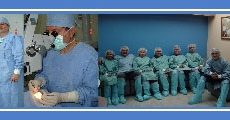
Cirugía electiva (instructivo)
San Cristóbal: (0276) 343-7209 | Caracas: (0212) 576-4038 | Ciudad de México: +52-55-5574-9398 | Puebla: +52-222-290-7591

The Cornea Transplant surgery is the most common and the best prognosis of all organ transplants in humans. It consists of removing the central part of the cornea of the patient and replace it with a donor cornea.
What is the cornea?
The optical system of the eye is like a camera and the lens above correspond to the cornea, it is like a watch glass.
Who may need a cornea?
Deciding which patient may warrant this surgery may take only the doctor for treatment advice. This surgery is performed on people who have:
1. Corneas with high curvature and tapered and it is not possible to improve their visual quality contact lenses. (Keratoconus)
2. Weakening after corneal cataract surgery. (Bullous keratopathy)
3. corneal scar after penetrating wound.
4. Scarring after infections by viruses, fungi or bacteria.
5. Problems with hereditary corneal opacity.
Who performs this surgery?
The doctor must perform an ophthalmologist specializing in cornea, trained to perform this surgery with a precise technique and has knowledge to guide his patient with a cornea problem.The corneal graft surgery is to replace the central part of its damaged by a healthy cornea. The cornea is obtained from the donor after the first 6 hours after deceased, who generously donated his eyes to you. I could restore vision, which is a final act of solidarity. The donor cornea is preserved properly in order to keep it alive for 3 to 10 days under refrigeration. He also has been studied in Eye Bank to ensure its viability and is free of contagious diseases.
What results can be expected?
Fortunately Corneal Collagen is a special fabric that has no vessels and this decreases by 90% the risk of transplant rejection. If given early treatment can stop an event with minimal rejection of corneal injury.
Where one donor cornea is obtained?
Corneal transplantation is a surgery that depends on the donation of corneas to the Eye Bank. Corneas are obtained from recently deceased donors. The tissue is studied strictly and rigorously by specialists in the Eye Bank staff and choose those with the best condition to be successfully transplanted.
What is an Eye Bank?
It is a non-profit institution composed of technical and medical staff prepared to carry out the process of obtaining and distribution of ocular tissues.
CORNEAL TRANSPLANT: PRE-OPERATIVE RECOMMENDATIONS
1. Read and follow the instructions of elective surgeries. Laboratory tests should be performed between the 3 months prior to surgery.
2. Your last evaluation at our center should not be more than 3 months, because if your surgery was scheduled earlier, your condition may have changed and it is important to revisit it to get the best visual prognosis.
3. The procedure for payment of surgery should organize previously. The stay in the city after surgery should be a week, ask the secretary if you need guidance.
4. It must be in optimal health. We recommend a visit to the dentist to avoid the presence of dental caries and should not have problems with sinusitis, can be a source of infection and cause of transplant rejection.
5. Must attend their preoperative evaluation before surgery. This appointment must apply to the secretaries.
6. To take a shower and wash your hair in the morning before going to surgery. Do not use makeup.
7. The day of surgery: If surgery is before 12 p.m. you should not eat
8 hours earlier. If surgery is after 12 p.m. CAN light breakfast (fruit juice, sandwich, soup, corn bread with cheese). 8. Remember assist your post-operative monitoring, the day after surgery. You should wear sunglasses to protect from strong light, sunlight or accidental bumps.
9. It should be organized to assist their post-operative controls. Initial control could be every day between 7 to 15 days and then after a month, third month, sixth month and each time the doctor tells you. The the removal of stitches will start 6 month latar based on refractive control and corneal topography. (Each case is handled according to clinical response).
CORNEAL TRANSPLANT: POST OPERATIVE RECOMMENDATIONS
Dear Patient:
Through this tutorial we want to give some recommendations on the general care that you and your family should consider for your speedy recovery.
Degree of vision post operative increases progressively as healing goes. Physical activity should be soft in the first month after surgery, you can resume your normal duties of work or study a month after the surgery, unless its activities are conducted in exposed environments such as:. Agricultural environments (Country) , work in industries and environments contaminated with dust, chemicals, gases, etc. In such cases, the rest could take up to 2 month.
Corneal transplantation is a high-precision surgery being immunologically privileged corneal tissue by the absence of vascularization. The cornea placed in your eye must be accepted by your own body and fortunately it is one of the few structures that can be transplanted with high probability of success. However after this surgery it is necessary to know the symptoms of rejection because if this happens it is necessary that the patient meets the prescribed treatment and be immediately evaluated in our clinic. Generally this situation are able to control and cornea is not damaged. If you have these symptoms may be beginning a phenomenon of rejection of transplanted tissue.
SYMPTOMS REJECTION:
To avoid losing the transplant you should follow the following recommendations:
1. Prednefrin or Aflarex: Apply one (1) drop every hour from 7:00 a.m. to 7:00 p.m. until you go to the Opthalmologist.
2. Call one of our offices even if you do not have an appointment, you see a doctor urgently preferably in the first 24 to 48 hours of onset symptoms and will be attended by any of the Ophthalmologists of our team.